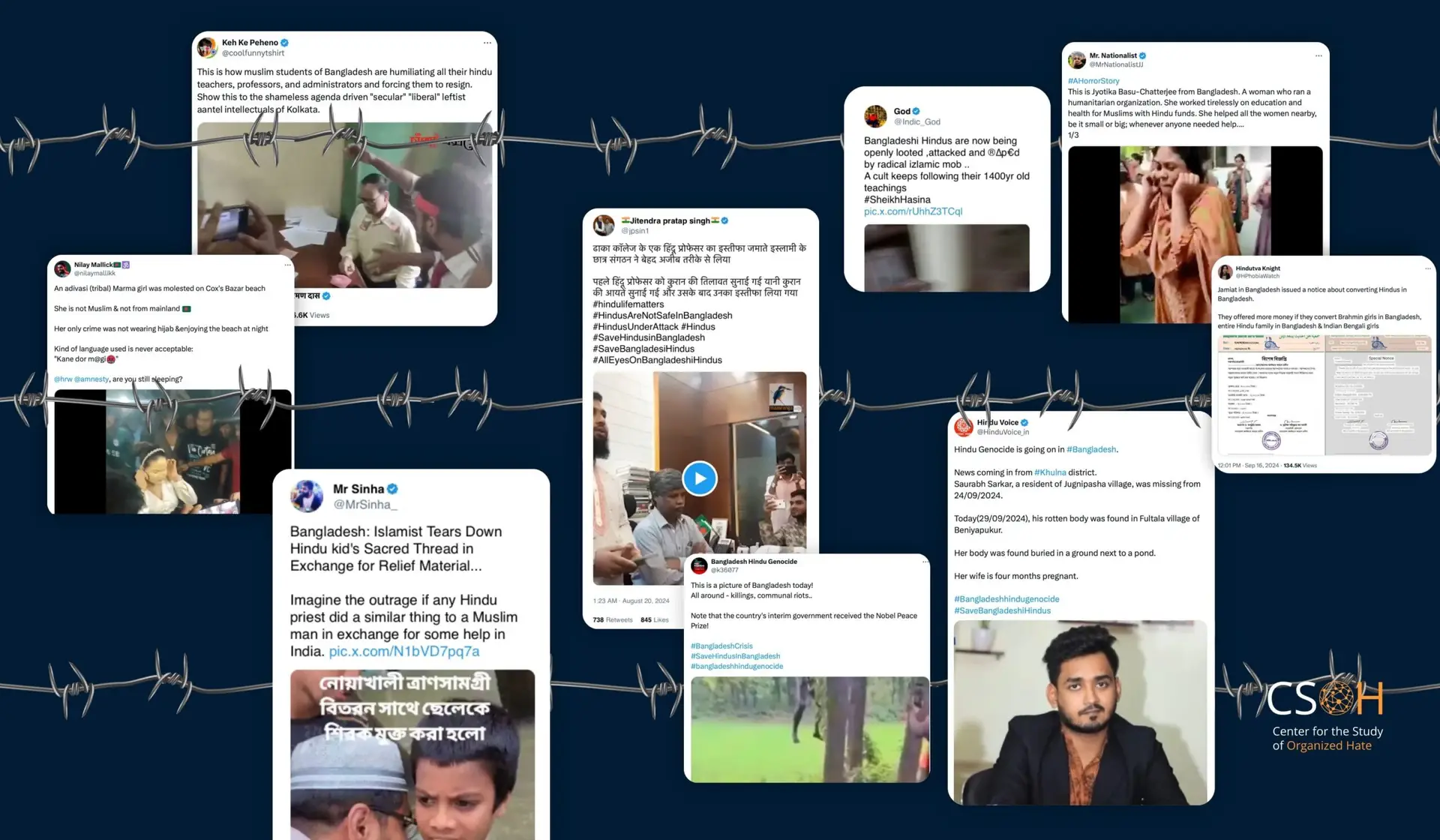In an age where falsehoods travel faster than facts, disinformation has become a potent weapon in shaping political realities. The recent expulsion of Bangladesh’s former Prime Minister, Sheikh Hasina, sparked a surge of disinformation and misinformation, with reports of alleged widespread violence against the Hindu minority flooding India’s mainstream media and social media platforms. Claims of a “Hindu genocide” quickly gained traction, but many of these accounts have been debunked as exaggerated or false by fact-checkers. This incident, however, highlights the far-reaching implications and complex role of misinformation and disinformation in shaping public perceptions and exacerbating religious animosity, raising concerns about the potential impact on social cohesion in both India and Bangladesh.
As political unrest gripped the country after Sheikh Hasina’s departure, there were several incidents of violence in Bangladesh – largely directed at the supporters of her Awami League (AL) party — including those on Hindu-owned homes and businesses. These attacks, as confirmed by fact-checkers and media reports, were driven primarily by political motivations rather than religious animosity. However, on social platforms and Indian media outlets, the narrative surrounding these attacks shifted, with reports of religiously motivated violence against Hindus gaining traction.
This was further reinforced by the wide circulation of hashtags such as #SaveBangladeshiHindus and #HindusUnderAttacked across multiple platforms, predominantly pushed by accounts run by Hindu nationalist supporters. Indian media outlets also picked up on this, amplifying stories of anti-Hindu violence, further entrenching a perception of a large-scale Hindu persecution that was not the case here. While communal tensions in Bangladesh are a sensitive issue, these narratives tap into historical grievances against minorities and seek to inflame passions among the Hindu majority in India.
Online Narratives and its Impact in India
India’s experience with disinformation is not new: it ranks among the countries most at risk of misinformation and disinformation, according to the World Economic Forum’s 2024 Global Risk Report. The disinformation surrounding Bangladesh attempts to create social unrest, with potentially dangerous consequences on India’s own internal cohesion.
In India, religious polarisation remains an ever-present issue. The rise and mainstreaming of Hindu nationalism, fuelled by the ruling Bharatiya Janata Party (BJP) and its affiliates, has created a socio-political environment where Islamophobia is tolerated and even encouraged. By amplifying claims of anti-Hindu violence in Bangladesh, pro-Hindu nationalist actors are not only stoking fears of external threats – in this case, from Bangladesh, an immediate neighbor – but also reinforcing the internal narratives of Muslims as “others” and enemies of the “Hindu identity.” The consequences of this polarization are profound, furthering the marginalization of Muslim communities, fuelling communal violence, and further eroding the secular fabric that has been a cornerstone of the Indian state.
The consequences of this hate and bigotry extend beyond domestic boundaries. Bangladesh is India’s immediate neighbor and shares deep cultural and economic ties. Fostering Islamophobic sentiments against Bangladesh’s Muslim-majority population could strain diplomatic relations and destabilize cross-border security cooperation. This is particularly important in the aftermath of the discriminatory Citizenship Amendment Act (CAA), passed by the Indian parliament in 2019, which is already threatening border relations.
With India’s diverse religious and ethnic population, tensions can escalate when communal issues are framed in stark and adversarial terms. In this context, digital disinformation contributes to a cycle of mistrust where communities are viewed as victims or aggressors – depending on the framing of the narratives.
Bangladesh’s Challenges
The effect of this disinformation also has significant implications for Bangladesh. The Hindu minority, which has traditionally supported Hasina’s Awami League, has found itself vulnerable in a politically volatile environment. In the weeks following Hasina’s departure, there have been numerous incidents of violence, but portraying these as exclusively religiously motivated also risks inflaming tensions between the Hindu-Muslim communities within Bangladesh itself.
The current interim government in Bangladesh, led by Nobel Laureate Muhammad Yunus, must navigate these challenges with caution in this transitional period.
Efforts to protect minority communities are essential, but addressing the political context in which these incidents occur is equally important. The ease with which misinformation crosses borders in this digital age poses a real risk of external narratives aggravating Bangladesh’s social and political landscape.
Big Tech’s Role
The dissemination of hateful and divisive narratives online in a politically charged environment illustrates the dangerous potential of disinformation. In both India and Bangladesh, misinformation and disinformation targeting a particular community – in this case, Bangladeshi Hindus – can deepen existing divisions and lead to further fragmentation.
Tech platforms like Meta,TikTok and X (formerly Twitter) must take proactive steps to effectively combat disinformation. In this particular case, having subject-matter experts who understand the socio-political nuances of the Indian-Bangladeshi context as human content moderators is essential.
Platforms should also continue to establish robust partnerships with local fact-checking organizations to promptly identify and address false narratives and stay on top of disinformation trends. Understanding how disinformation spreads also requires us to critically evaluate the role of social media algorithms in amplifying divisive content. Platforms are heavily prioritizing engagement and pushing emotionally charged posts that are easily sensationalized and created to go viral, regardless of if they are rooted in facts. This creates a constant feedback loop of outrage.
As more users engage with disinformation—whether by agreeing or refuting it— a multiplier effect is achieved, pushing the dangerous fringe narratives into the mainstream
(Antara Chakraborthy is a Senior Research Analyst at the Centre of Excellence for National Security (CENS), RSIS, Singapore.)
